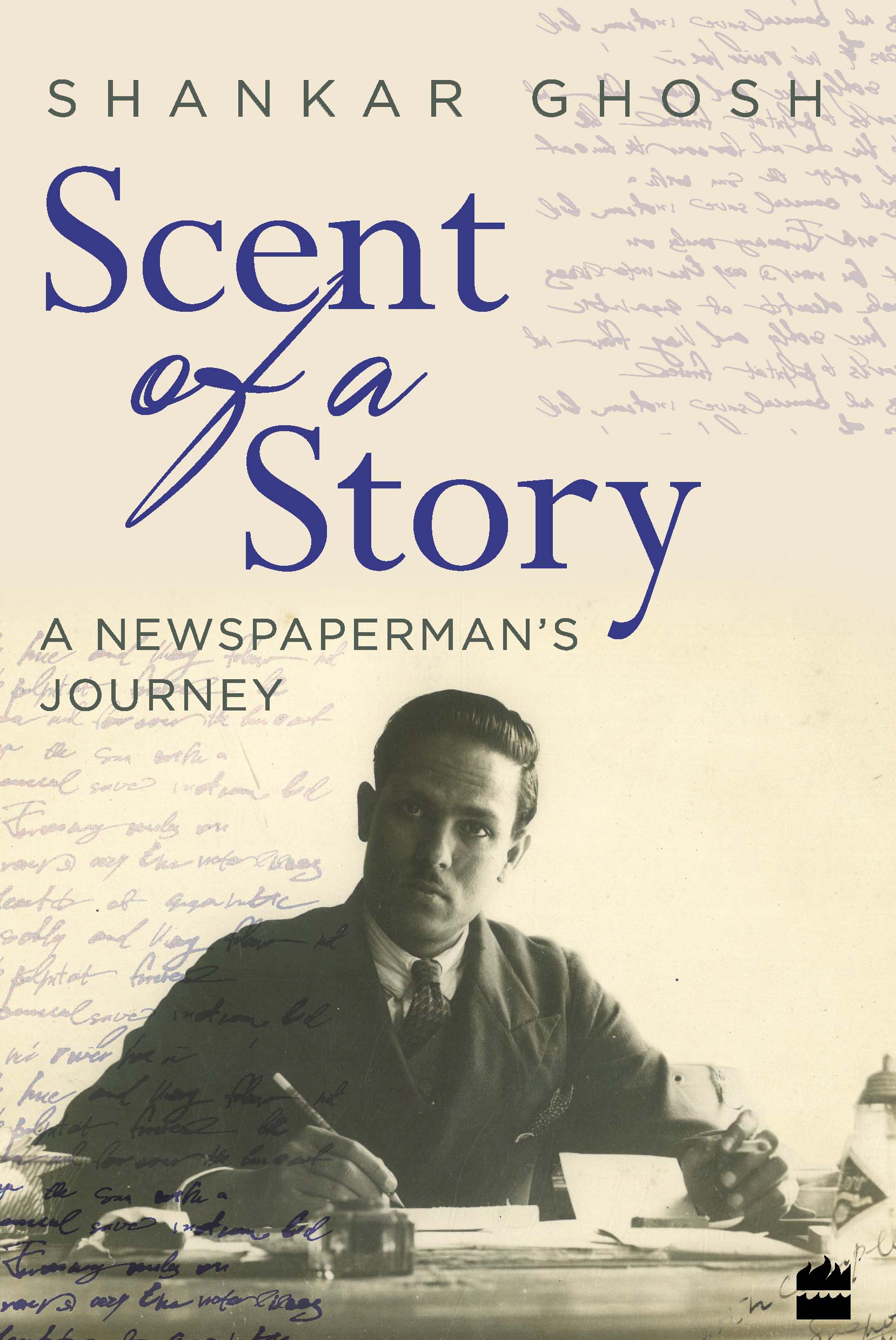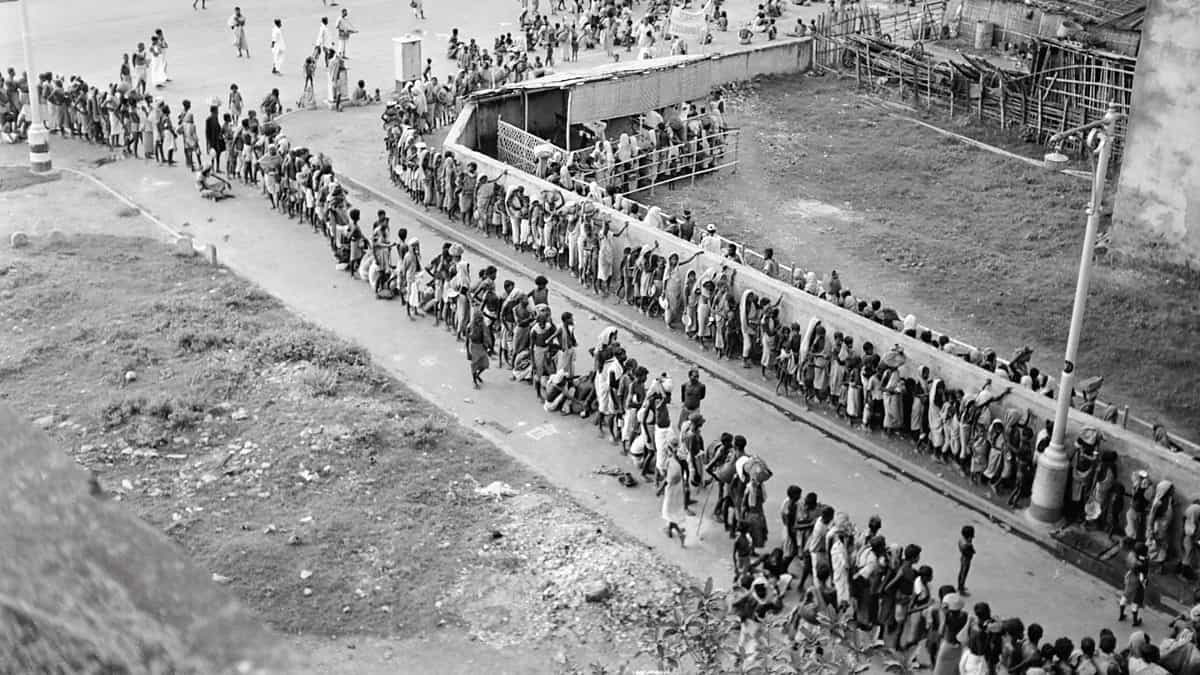Jagabandhu’s father was a carpenter in Jessore, and he used to help out his father in their shop. His mother had died when he was about ten years old, and his eldest sister, who was five years his senior, had looked after the household. He had another sister, about a year older, but she had typhoid in infancy and was mentally retarded.
Tragedy struck the household when Jagabandhu was about seventeen years of age in early 1942. It all started with rumours. The foodgrain shops would only bring in small quantities to sell each day. Normally petty tradesmen and odd-job workers would buy rice and other staples at the end of the day with their day’s earnings. But of late the shops would either be empty or be shut by afternoon; prices went up on an hourly basis. The rumours became stronger: there was shortage of food because the government had bought up the whole crop and had sent it to feed soldiers in different lands.
Jagabandhu’s father could not find work. Everyone was spending all they had to stock up on rice. The family had no option but to move out of Jessore. The household deities were cleaned, given a few grains of rice and offered last prayers. Jagabandhu said that it was his eldest sister, Alpona, who cried the most. She took a long time in talking to the idols and repeatedly telling them that she would return soon and look after them again.
The house was locked and the family set off on a vague search for food. The ultimate goal was to get to Calcutta, as one was sure to find work in that large city. Their first camp was on the way to a place called Jhanpa, a grain market where they hoped to buy some food. However, it appeared that a vast multitude had the same thought.
They moved in a sea of people and saw the grain markets of Jhanpa totally bereft of any kind of grain. The place was a ghost town. Some children and infirm were making weak attempts to beg for food, knowing fully well that there was no hope of succour from people who themselves were beggars.
The family moved on through Sharsha town, towards the Betna river, where they planned to get hold of a boat and move towards Bongaon, as it was becoming increasingly difficult to walk on empty bellies. It was somewhere between Charatala and the Betna river ghat that Jagabandhu lost both his sisters.
They had sifted through an old heap of rice husk in an abandoned home – the kind of heap that is left after threshing parboiled rice – and had found some discoloured grain. The boiled grain was not enough for all, so the menfolk had feigned satiation and had the last tiny bit of parched rice and gur, while the girls had the rice. The girls complained of stomach pain at night and by morning were badly dehydrated. The next day saw no let-up in continuous diarrhoea and, the day after, father and son moved on after burying the sisters’ bodies in a shallow grave.
The duo reached Calcutta in a state of severe starvation, to find that Calcutta was nowhere near the city of their dreams. The streets were full of starving humanity; families had sold off their girls to stay alive for a few more days; and pestilence was almost upon them, with human bodies rotting in the streets.
Around 9 a.m., by a stroke of luck, they found themselves near the Salvation Army building. It was a red brick building, with a brick-lined drain all around. They saw a row of people sitting by the side of the drain with tin cups, mugs, plates, glasses, almost any kind of container. On inquiry they were told that rice was prepared twice a day, in the morning and evening, and the starch drained in the kitchen found its way to the side drains and could be collected if one were quick enough. The duo lived off the drains for a few days and then Jagabandhu said his father died of a broken heart. One evening he was there and the next morning he was gone. Jagabandhu had also lost his will to live and was aimlessly roaming the streets till he collapsed in front of Captain N.N. Chowdhury’s doorway.
I too got a whiff of the great calamity. For reasons unfathomable, there were all kinds of restrictions on the transport of foodgrains. There was grain rotting in the Punjab, but traders couldn’t send it to Bengal. Bi made at least five trips to her home in Calcutta from Lucknow in 1943 and 1944 with our children, and most of her luggage was filled with rice. The ‘holdall’, mattress, pillows were all full of rice. I used to be on tenterhooks till I got word of her safe arrival. If caught by the railway or police authorities, she would have been treated as a common criminal.
The only journalist (I am not including the vernacular press) I can think of who tried to highlight news about the famine was Ian Stephens, editor of the Calcutta-based and British-owned the Statesman. In a series of hard-hitting articles, especially those of 14 and 16 October 1943, he gave a graphic account of the famine, and delivered a stinging critique of inaction of the administration. Further, he had visiting cards made with his name on one side and the most gruesome pictures of death on the streets by starvation in Calcutta on the other, and made sure that all senior officers in Delhi got at least one. It was thanks to him that the ‘Famine Code’ was finally declared and the dying gradually came to an end.
In 1935 I had become the chief reporter of the Pioneer, and had worked in this capacity for a brief period of about four years. But somehow the name ‘chief ’ stuck on for the rest of my working life. I didn’t mind the appellation at all. But when Ian Stephens’s writings had me all fired up and I wrote an impassioned second leader on the famine, it caused me a bit of grief. I was told in no uncertain terms that the moniker ‘chief ’ had perhaps gone to my head and that there was a war to be won, and such talk was bad for army morale and grist for the enemy propaganda mills. The same person, though, appreciated the quality of my write-up!
As a final wrap-up job on the famine, a commission was set up, with the greatest care given to the selection of ‘compliant’ committee members, and all the evidence presented to the commission was held in camera. As a further precaution, the evidence collected was ordered to be destroyed after the final report was filed. Sir Mani Lal Nanavati, one of the committee members, managed to save his copies and these ended up in the National Archives of India, buried under a ‘Restricted’ tag (the Nanavati Papers).
The final report was signed in August 1945: a beautifully written document, full of information, and as expected – utterly misleading. Moreover, the war was over, the horrors of the famine had faded with time and, with public attention focused on getting on with life – all with Viceroy Archibald Wavell’s skills of procrastination and obfuscation – the famine became an invisible event in Indian and world history: Famine? What famine?

Excerpted with permission from Scent of a Story: A Newspaperman’s Journey, by Shankar Ghosh, HarperCollins India.
Price: Rs 304; Buy the book here.
Cover picture courtesy: factslegend.org

